Coexistence of Diversified Dog Socialities and Territorialities in the City of Concepción, Chile
Simple Summary
Abstract
1. Introduction
1.1. Background: Research on Forms of Canine Territoriality
1.2. Emergence of the Various Categories of Domestic Dogs
- -
- restricted dogs, which are totally dependent upon people: all their essential needs are intentionally met by humans, who also restrict their movement;
- -
- family dogs, which have owners on whom they depend, although they may be free to roam. Their reproduction is supervised by humans;
- -
- stray dogs, which include dogs living in a human-dominated context. This is a heterogeneous group: it includes dogs that still have a social bond with humans, possibly abandoned or born in human settings, and which tend to associate food with particular households [29,30], even when the homeowners claim that the dogs do not belong to them (Type I) [31] and dogs that exhibit varying degrees of fear/tolerance toward humans (Type II). These dogs are attracted to human settings by the availability of food and shelter, regardless of whether these resources are intentionally provided by humans or just casually associated with them. They have close proximity to humans, and beg from them rather than scavenging [32]. These two types of stray dogs, with two possible levels of relationship toward humans, are sometimes referred to as village dogs [31,33]. They are found roaming in many of the large cities of the Mediterranean basin (Istanbul, Alexandria);
- -
2. Materials and Methods
3. Results
3.1. Plaza Perú and Adjacent Areas
3.1.1. Dogs Adapt Their Territory to the City
3.1.2. Passages, Boundaries and Landmarks of the Urban Canine Territory
3.2. Snoopy from Yugoslavia Street in Hualpén
3.2.1. The Street Dog’s Domestic Neighborhood
3.2.2. The Dog as a Component of the Neighborhood’s Identity
4. Discussion
4.1. Diverse Adaptations of Dogs to Diverse Urban Morphologies
4.2. The City as Life Learning: Territorialities
5. Conclusions
Author Contributions
Funding
Acknowledgments
Conflicts of Interest
Appendix A
Appendix B
Appendix C
Appendix D
- Here is a typical instance of dogs following pedestrians to use a crosswalk. [accessed on 21 December 2019]
- In this video, it is not possible to determine how the dog crosses the crosswalk. [accessed on 21 December 2019]
- This video shows that the dog uses a bridge to cross the street, as there is no crosswalk. [accessed on 21 December 2019]
References
- Bradshaw, J. Defence of Dogs; Penguin Books: London, UK, 2011. [Google Scholar]
- Ritchie, E.G.; Dickman, C.R.; Letnic, M.; Vanak, A.T.; Gommper, M. Dogs as predators and trophic regulators. In Free-Ranging Dogs and Wildlife Conservation; Gompper, M., Ed.; Oxford University Press: Oxford, UK, 2014; pp. 55–68. [Google Scholar]
- Latcham, R.E. Los Animales Domésticos de la América Precolombiana; Cervantes: Santiago, Chile, 1823. [Google Scholar]
- Acosta-Jamett, G.; Cleaveland, S.; Cunningham, A.; Bronsvoort, B.D. Demography of domestic dogs in rural and urban areas of the Coquimbo region of Chile and implications for disease transmission. Prev. Veter. Med. 2010, 94, 272–281. [Google Scholar] [CrossRef] [PubMed]
- Vaughan, C. Turkish Animal Welfare Bill—Is It Working? 2011. Available online: http://kangal.ca/dogs-in-turkey/turkish-animal-welfare-bill-is-it-working/ (accessed on 21 December 2019).
- Southwick, C.H.; Beg, M.A.; Siddiqi, M.R. A Population Survey of Rhesus Monkeys in Villages, Towns and Temples of Northern India. Ecology 1961, 42, 538–547. [Google Scholar] [CrossRef]
- Priston, N.E.C.; McLennan, M.R. Managing humans, managing macaques: Human—Macaque conflict in Asia and Africa. In The Macaque Connection: Cooperation and Conflict between Humans and Macaques, Developments in Primatology: Progress and Prospects; Radhakrishna, S., Ed.; Springer: Berlin, Germany, 2013; pp. 225–250. [Google Scholar]
- Bateman, P.W.; Fleming, P.A. Big city life: Carnivores in urban environments. J. Zool. 2012, 287, 1–23. [Google Scholar] [CrossRef]
- Mueller, M.A.; Drake, D.; Allen, M.L. Coexistence of coyotes and red foxes in an urban landscape. PLoS ONE 2018, 13, e0190971. [Google Scholar] [CrossRef]
- Majumder, S.S.; Chatterjee, A.; Bhadra, A. A dog’s day with humans—Time activity budget of free-ranging dogs in India. Curr. Sci. 2014, 106, 874–878. [Google Scholar]
- Axelsson, E.; Ratnakumar, A.; Arendt, M.L.; Maqbool, K.; Webster, M.T.; Perloski, M.; Liberg, O.; Arnemo, J.M.; Hedhammar, A.; Lindblad-Toh, K. The genomic signature of dog domestication reveals adaptation to a starch-rich diet. Nature 2013, 495, 360–364. [Google Scholar] [CrossRef]
- Urbanik, J. Placing Animals: An Introduction to the Geography of Human-Animal Relations; Rowman & Littlefield: Lanham, MA, USA, 2012. [Google Scholar]
- McKnight, T.; Wolch, J.; Emel, J. Animal Geographies: Place, Politics, and Identity in the Nature- Culture Borderlands. Geogr. Rev. 1998, 88, 608. [Google Scholar] [CrossRef]
- Beck, A.M. The Ecology of Stray Dogs: A Study of Free-Ranging Urban Animals; Purdue University York Press: West Lafayette, IN, USA, 1973. [Google Scholar]
- Fox, M.; Beck, A.; Blackman, E. Behavior and ecology of a small group of urban dogs. Appl. Anim. Ethol. 1975, 1, 119–137. [Google Scholar] [CrossRef]
- Berman, M.; Dunbar, I. The social behaviour of free-ranging suburban dogs. Appl. Anim. Ethol. 1983, 10, 5–17. [Google Scholar] [CrossRef]
- Boitani, L.; Francisci, F.; Ciucci, P.; Andreoli, G. Population biology and ecology of feral dogs in Italy. In The Domestic Dog: Its Evolution, Behavior and Interactions with People; Serpell, J.A., Ed.; Cambridge University Press: Cambridge, UK, 1995; pp. 218–244. [Google Scholar]
- Beck, A.M. The ecology of urban dogs. In The Handbook of Animal Welfare. Biomedical, Psychological, and Ecological Aspects of Pet Problems and Control; Allen, R.D., Westbrook, W.H., Eds.; Garland STPM Press: New York, NY, USA, 1979; pp. 51–55. [Google Scholar]
- Font, E. Spacing and social organization: Urban stray dogs revisited. Appl. Anim. Behav. Sci. 1987, 17, 319–328. [Google Scholar] [CrossRef]
- Gaunet, F.; Pari-Perrin, E.; Bernardin, G. Description of Dogs and Owners in Outdoor Built-Up Areas and Their More-Than-Human Issues. Environ. Manag. 2014, 54, 383–401. [Google Scholar] [CrossRef] [PubMed]
- Brubaker, L.; Dasgupta, S.; Bhattacharjee, D.; Bhadra, A.; Udell, M.A.R. Differences in problem-solving between canid populations: Do domestication and lifetime experience affect persistence? Anim. Cogn. 2017, 279, 4087–4723. [Google Scholar] [CrossRef] [PubMed]
- Morris, D. Dogwatching; Three Rivers Press: New York, NY, USA, 1987. [Google Scholar]
- Ovodov, N.D.; Crockford, S.J.; Kuzmin, Y.V.; Higham, T.F.G.; Hodgins, G.W.L.; Van Der Plicht, J. A 33,000-Year-Old Incipient Dog from the Altai Mountains of Siberia: Evidence of the Earliest Domestication Disrupted by the Last Glacial Maximum. PLoS ONE 2011, 6, e22821. [Google Scholar] [CrossRef] [PubMed]
- Ivanter, E.V.; Sedova, N.A. Ecological monitoring of urban groups of stray dogs: An example of the city of petrozavodsk. Russ. J. Ecol. 2008, 39, 105–110. [Google Scholar] [CrossRef]
- Boitani, L.; Fabbri, M.L. Censimento dei cani in Italia con particolare riguardo al fenomeno del randagismo. Ric. Biol. Selvag. 1983, 73, 1–51. [Google Scholar]
- Beck, A.M. Foreword. In What is A Dog? Coppinger, R., Coppinger, L., Eds.; University of Chicago Press: Chicago, IL, USA, 2016. [Google Scholar]
- Perry, B.D. Dog ecology in eastern and southern Africa: Implications for rabies control. Onderstepoort J. Veter. Res. 1993, 60, 429. [Google Scholar]
- Boitani, L.; Ciucci, P.; Ortolani, A. Behaviour and social ecology of free-ranging dogs. In The Behavioural Biology of Dogs; Jensen, P., Ed.; CAB International: Wallingford, UK, 2007; pp. 147–165. [Google Scholar]
- Boitani, L.; Racana, A. Indagine Eco-Etologica Sulla Popolazione di Cani Domestici e Randagi di Rue Comuni Della Basilicata; Silva Lucana: Bari, Italy, 1984; Volume 3, pp. 1–86. [Google Scholar]
- De Balogh, K.K.; Wandeler, A.I.; Meslin, F.X. A dog ecology study in an urban and a semi-rural area of Zambia. Onderstepoort J. Veter. Res. 1993, 60, 437–443. [Google Scholar]
- Ortolani, A.; Vernooij, H.; Coppinger, R. Ethiopian village dogs: Behavioural responses to a stranger’s approach. Appl. Anim. Behav. Sci. 2009, 119, 210–218. [Google Scholar] [CrossRef]
- Majumder, S.S.; Paul, M.; Sau, S.; Bhadra, A. Denning habits of free-ranging dogs reveal preference for human proximity. Sci. Rep. 2016, 6, 32014. [Google Scholar] [CrossRef]
- Macdonald, D.W.; Carr, G.M. Variation in dog society: Between resource dispersion and social flux. In The Domestic Dog: Its Evolution, Behaviour, and Interactions with People; Serpell, J., Ed.; Cambridge University Press: Cambridge, UK, 1995; pp. 199–216. [Google Scholar]
- Daniels, T.J.; Bekoff, M. Population and Social Biology of Free-Ranging Dogs, Canis familiaris. J. Mammal. 1989, 70, 754–762. [Google Scholar] [CrossRef]
- Causey, M.K.; Cude, C.A. Feral Dog and White-Tailed Deer Interactions in Alabama. J. Wildl. Manag. 1980, 44, 481–484. [Google Scholar] [CrossRef]
- Boitani, L.; Ciucci, P. Comparative social ecology of feral dogs and wolves. Ethol. Ecol. Evol. 1995, 7, 49–72. [Google Scholar] [CrossRef]
- Nesbitt, W.H. Ecology of a feral dog pack on a wildlife refuge. In The Wild Canids: Their Systematics, Behavioural Ecology and Evolution; Fox, M.W., Ed.; Van Norstrand Rheinhold: New York, NY, USA, 1975; pp. 391–395. [Google Scholar]
- Riolon, L. L’évolution en Marche: Les Chiens Errants de Moscou. 2017. Available online: https://rutube.ru/video/404bed3d164937026d7edadb200ae3d8/ (accessed on 8 April 2018).
- Coppinger, R.; Coppinger, L. Dogs: A Startling New Understanding of Canine Origin, Behaviour and Evolution; University of Chicago Press: Chicago, IL, USA, 2002. [Google Scholar]
- Lindsay, S.R. Handbook of Applied Dog Behavior and Training, Adaptation and Learning; John Wiley & Sons: New York, NY, USA, 2013. [Google Scholar]
- Elgier, A.M.; Jakovcevic, A.; Barrera, G.; Mustaca, A.E.; Bentosela, M. Communication between domestic dogs and humans: Dogs are good learners. Behav. Process. 2009, 81, 402–408. [Google Scholar] [CrossRef] [PubMed]
- Barrera, G.; Jakovcevic, A.; Mustaca, A.; Bentosela, M. Learning interspecific communicative responses in Pampas foxes. Behav. Process. 2012, 89, 44–51. [Google Scholar] [CrossRef]
- Scott, J.P.; Fuller, J.L. Genetics and the Social Behavior of the Dog; University of Chicago Press: Chicago, IL, USA, 1965. [Google Scholar]
- Wynne, C.D. What is special about dog cognition? Curr. Direct. Psych. Sci. 2016, 25, 345–350. [Google Scholar] [CrossRef]
- Bhattacharjee, D.; Dev, N.; Gupta, S.; Sau, S.; Sarkar, R.; Biswas, A.; Banerjee, A.; Babu, D.; Mehta, D.; Bhadra, A. Free-ranging dogs show age related plasticity in their ability to follow human pointing. PLoS ONE 2017, 12, e0180643. [Google Scholar] [CrossRef]
- Fox, M.W. The Dog: Its Domestication and Behavior; Garland Publishing Inc.: New York, NY, USA, 1978. [Google Scholar]
- Daniels, T.J. The social organization of free-ranging urban dogs. I. Non-estrous social behavior. Appl. Anim. Ethol. 1983, 10, 341–363. [Google Scholar] [CrossRef]
- Pal, S. Urine marking by free-ranging dogs in relation to sex, season, place and posture. Appl. Anim. Behav. Sci. 2003, 80, 45–59. [Google Scholar] [CrossRef]
- Pal, S.K. Factors influencing intergroup agonistic behaviour in free-ranging domestic dogs. Acta Ethol. 2015, 18, 209–220. [Google Scholar] [CrossRef]
- Lyu, P. Proposal on Solutions to Stray Dog Problem in American Cities. J. Polit. Sci. Public Aff. 2015, 3, 175. [Google Scholar] [CrossRef]
- Coppinger, R.; Coppinger, L.; Beck, A. What Is a Dog? University of Chicago Press: Chicago, IL, USA, 2016. [Google Scholar]
- Fielding, W.J.; Mather, J.; Isaacs, M. Responsibilities of owners towards pets. In Dog Ownership in New Providence; Beck, A., Ed.; Purdue University Press: Nassau, The Bahamas, 2005; pp. 45–56. [Google Scholar]
- Anderson, E.N.; Schwartz, M. A History of Dogs in the Early Americas. Ethnohistory 1998, 45, 808. [Google Scholar] [CrossRef]
- Descola, P.; Lloyd, J.; Sahlins, M. Beyond Nature and Culture; University of Chicago Press: Chicago, IL, USA, 2013. [Google Scholar]
- Sánchez, H. Periurbanización y espacios rurales en la periferia de las ciudades. Procuraduría Agraria. Estud. Agrar. 2009, 41, 93–123. [Google Scholar]
- Sepúlveda, M.A.; Singer, R.S.; Silva-Rodríguez, E.; Stowhas, P.; Pelican, K. Domestic dogs in rural 1073communities around protected areas: Conservation problem or conflict solution? PLoS ONE 2014, 9, e86152. [Google Scholar] [CrossRef] [PubMed]
- Gaunet, F.; El Massioui, F. Marked referential communicative behaviours, but no differentiation of the “knowledge state” of humans in untrained pet dogs versus 1-year-old infants. Anim. Cogn. 2014, 17, 1137–1147. [Google Scholar] [CrossRef]
- Savalli, C.; Ades, C.; Gaunet, F. Are Dogs Able to Communicate with Their Owners about a Desirable Food in a Referential and Intentional Way? PLoS ONE 2014, 9, e108003. [Google Scholar] [CrossRef]
- Miklósi, Á. Dog Behaviour, Evolution, and Cognition; Oxford University Press: London, UK, 2014. [Google Scholar]
- Hodgetts, T.; Lorimer, J. Methodologies for animals’ geographies: Cultures, communication and genomics. Cult. Geogr. 2015, 22, 285–295. [Google Scholar] [CrossRef]
- Nimmo, R. Actor-Network Theory and Methodology: Social Research in a More-Than-Human World. Methodol. Innov. Online 2011, 6, 108–119. [Google Scholar] [CrossRef]
- Buller, H. Animal geographies II: Methods. Prog. Hum. Geogr. 2015, 39, 374–384. [Google Scholar] [CrossRef]
- Kirksey, S.E.; Helmreich, S. The emergence of multispecies ethnography. Cult. Anthropol. 2010, 25, 545–576. [Google Scholar] [CrossRef]
- Birke, L.; Hockenhull, J. Crossing Boundaries: Investigating Human-Animal Relationships; Brill: Leiden, The Netherland, 2012. [Google Scholar]
- Alger, J.; Alger, S. Cat Culture: The Social World of a Cat Shelter; Temple University Press: Philadelphia, PA, USA, 2003. [Google Scholar]
- Bear, C. Being Angelica? Exploring individual animal geographies. Area 2011, 43, 297–304. [Google Scholar] [CrossRef]
- Kovacs, B.; Gaunet, F.; Briffault, X. Les Techniques de l’activité Pour l’interaction Homme-Machine; Hermes Science-Lavoisier: Paris, France, 2004. [Google Scholar]
- Goode, D. Playing with My Dog Katie. An Ethnomethodological Study of Canine-Human Interaction; Purdue University Press: La Fayette, IN, USA, 2006. [Google Scholar]
- O’Reilly, K. Ethnographic Methods; Informa UK Limited: Colchester, UK, 2012. [Google Scholar]
- Yin, R.K. Case Study Research: Design and Methods; Sage Publications: Newberry Park, CA, USA, 1989. [Google Scholar]
- Capellà, H. El reencuentro de la plaza. Cuad. Geogr. Coll. 2014, 23, 39–45. [Google Scholar]
- TV Journal 1. By Sotomayor C, Concepción: Municipio deberá Erradicar a Perros Callejeros Tras Fallo de Corte Suprema Canal 24 h. 27 January 2016. Available online: http://www.24horas.cl/nacional/concepcion-municipio-debera-erradicar-a-perros-callejeros-tras-fallo-de-corte-suprema-1914592 (accessed on 21 December 2019).
- TV Journal 2. By Belmar V., Concepción Controlará Perros Callejeros Con Esterilización y Eutanasia. BioBio Chile. 21 April 2016. Available online: https://www.biobiochile.cl/noticias/2016/04/21/concepcion-controlara-perros-callejeros-con-esterilizacion-y-eutanasia.shtm (accessed on 21 December 2019).
- Gaunet, F.; Milliet, J. The relationship of visually impaired people with the guide dog: How could the use of dogs be further developed in France. Altern. Eur. J. Disabil. Res. 2010, 4, 116–133. [Google Scholar] [CrossRef]
- Deldalle, S.; Gaunet, F. Effects of 2 training methods on stress-related behaviors of the dog (Canis familiaris) and on the dog–owner relationship. J. Veter. Behav. 2014, 9, 58–65. [Google Scholar] [CrossRef]
- Coppinger, R.; Coppinger, L. Village dogs. In Dogs: A New Understanding of Canine Origin, Behavior and Evolution; Coppinger, R., Coppinger, L., Eds.; Scribner: New York, NY, USA, 2001; pp. 69–82. [Google Scholar]
- Dias, R.A.; Guilloux, A.G.; Borba, M.R.; Guarnieri, M.C.; Prist, R.; Ferreira, F.; Amaku, M.; Neto, J.S.; Stevenson, M. Size and spatial distribution of stray dog population in the University of São Paulo campus, Brazil. Prev. Veter. Med. 2013, 110, 263–273. [Google Scholar] [CrossRef] [PubMed]
- Bonanni, R.; Cafazzo, S. The social organisation of a population of free-ranging dogs in a suburban area of Rome: A reassessment of the effects of domestication on dogs’ behaviour. In The Social Dog: Behaviour and Cognition; Kaminski, J., Marshall-Pescini, S., Eds.; Elsevier Inc.: Amsterdam, The Netherlands, 2014; pp. 65–104. [Google Scholar]
- Alkan, A. Deportation as an Urban Stray Dogs Management Policy: Forest Dogs of Istanbul. Lex Localis 2016, 14, 613–635. [Google Scholar] [CrossRef]
- Fortuny, K. Islam, Westernization, and Posthumanist Place: The Case of the Istanbul Street Dog. ISLE Interdiscip. Stud. Lit. Environ. 2014, 21, 271–297. [Google Scholar] [CrossRef]
- Huber, L.; Range, F.; Virányi, Z. Dog Imitation and Its Possible Origins. In Domestic Dog Cognition and Behavior; Springer Berlin: Berlin, Germany, 2014; pp. 79–100. [Google Scholar]
- Paul, M.; Sen, S.; Sau, S.; Nandi, A.K.; Bhadra, A. High early life mortality in free-ranging dogs is largely influenced by humans. Sci. Rep. 2016, 6, 1–8. [Google Scholar] [CrossRef]
- Pongrácz, P. Social Learning in Dogs; Elsevier BV: Amsterdam, The Netherlands, 2014; pp. 249–293. [Google Scholar]
- Johnston, A.M.; Holden, P.C.; Santos, L.R. Exploring the evolutionary origins of overimitation: A comparison across domesticated and non-domesticated canids. Dev. Sci. 2016, 20, e12460. [Google Scholar] [CrossRef]
- Duranton, C.; Bedossa, T.; Gaunet, F. When facing an unfamiliar person, pet dogs present social referencing based on their owners’ direction of movement alone. Anim. Behav. 2016, 113, 147–156. [Google Scholar] [CrossRef]
- Duranton, C.; Bedossa, T.; Gaunet, F. Pet dogs synchronize their walking pace with that of their owners in open outdoor areas. Anim. Cogn. 2017, 21, 219–226. [Google Scholar] [CrossRef]
- Duranton, C.; Bedossa, T.; Gaunet, F. Do shelter dogs engage in social referencing with their caregiver in an approach paradigm? An exploratory study. Appl. Anim. Behav. Sci. 2017, 189, 57–65. [Google Scholar] [CrossRef]
- Szetei, V.; Miklósi, Á.; Topal, J.; Csányi, V. When dogs seem to lose their nose: An investigation on the use of visual and olfactory cues in communicative context between dog and owner. Appl. Anim. Behav. Sci. 2003, 83, 141–152. [Google Scholar] [CrossRef]
- Macdonald, D.W. The ecology of carnivore social behavior. Nature 1983, 301, 379–384. [Google Scholar] [CrossRef]
- Torres, P.C.; Prado, P.I. Domestic dogs in a fragmented landscape in the Brazilian Atlantic Forest: Abundance, habitat use and caring by owners. Braz. J. Boil. 2010, 70, 987–994. [Google Scholar] [CrossRef]
- Ruiz-Izaguirre, E.; Bokkers, E.A.; Ortolani, A.; Ortega-Pacheco, A.; De Boer, I.J. Human–dog interactions and behavioural responses of village dogs in coastal villages in Michoacán, Mexico. Appl. Anim. Behav. Sci. 2014, 154, 57–65. [Google Scholar] [CrossRef]
- Available online: https://fr-fr.facebook.com/SIR-PERRO-UDEC-513376365409530/ (accessed on 21 December 2019).
- Kuhne, F.; Hößler, J.C.; Struwe, R. Effects of human–dog familiarity on dogs’ behavioural responses to petting. Appl. Anim. Behav. Sci. 2012, 142, 176–181. [Google Scholar] [CrossRef]
- Cattet, J.; Etienne, A.S. Blindfolded dogs relocate a target through path integration. Anim. Behav. 2004, 68, 203–212. [Google Scholar] [CrossRef]
- Chapuis, N.; Varlet, C. Short cuts by dogs in natural surroundings. Q. J. Exp. Psychol. 1987, 39, 49–64. [Google Scholar]
- Fiset, S. Landmark-based search memory in the domestic dog. J. Comp. Psychol. 2007, 121, 345–353. [Google Scholar] [CrossRef]
- Fiset, S. Evidence for averaging of distance from landmarks in the domestic dog. Behav. Process. 2009, 81, 429–438. [Google Scholar] [CrossRef]
- Fiset, S.; Malenfant, N. Encoding of local and global cues in domestic dogs’ spatial working memory. Open J. Anim. Sci. 2013, 3, 1–11. [Google Scholar] [CrossRef]
- Fiset, S.; Beaulieu, C.; Leblanc, V.; Dubé, L. Spatial memory of domestic dogs for hidden objects in a detour task. J. Exp. Psychol. Anim. Behav. Process. 2007, 33, 497–508. [Google Scholar] [CrossRef] [PubMed]
- Séguinot, V.; Cattet, J.; Benhamou, S. Path integration in dogs. Anim. Behav. 1998, 55, 787–797. [Google Scholar] [CrossRef]
- Smith, B.P.; Litchfield, C.A. How well do dingoes, Canis dingo, perform on the detour task? Anim. Behav. 2010, 80, 155–162. [Google Scholar] [CrossRef]
- Whitstock, R.; Franck, L.; Haneline, R. Dog guides. In Foundations of Orientation and Mobility American Foundation for the Blind; Blasch, B., Weiner, W., Welsh, R., Eds.; American Foundation for the Blind: New York, NY, USA, 1997; pp. 260–283. [Google Scholar]
- Gaunet, F.; Besse, S. Guide dogs’ navigation after a single journey: A descriptive study of path reproduction, homing, shortcut and detour. PLoS ONE 2019, 14, e0219816. [Google Scholar] [CrossRef] [PubMed]
- Johnston, B. The Skillful Mind of the Guide Dog: Towards a Cognitive and Holistic Model of Training; KNS Ediciones: Santiago Compostela, Spain, 2014. [Google Scholar]
- Duranton, C.; Jeannin, S.; Bedossa, T.; Gaunet, F. Studying episodic memory: Dogs as a biological model? Med. Sci. 2017, 33, 1089–1095. [Google Scholar]
- McNeill, A.T.; Leung, L.K.P.; Goullet, M.S.; Gentle, M.N.; Allen, B.L. Dingoes at the Doorstep: Home Range Sizes and Activity Patterns of Dingoes and Other Wild Dogs around Urban Areas of North-Eastern Australia. Animal 2016, 6, 48. [Google Scholar] [CrossRef]
- Howell, T.J.; Mornement, K.; Bennett, P.C. Pet dog management practices among a representative sample of owners in Victoria, Australia. J. Veter. Behav. 2016, 12, 4–12. [Google Scholar] [CrossRef]
- Smith, B.P.; Appleby, R.G.; Litchfield, C.A. Spontaneous tool-use: An observation of a dingo (Canis dingo) using a table to access an out-of-reach food reward. Behav. Process. 2012, 89, 219–224. [Google Scholar] [CrossRef]
- Cafazzo, S.; Natoli, E.; Valsecchi, P. Scent-Marking Behaviour in a Pack of Free-Ranging Domestic Dogs. Ethology 2012, 118, 955–966. [Google Scholar] [CrossRef]
- Duranton, C.; Bedossa, T.; Gaunet, F. Interspecific behavioural synchronization: Dogs exhibit locomotor synchrony with humans. Sci. Rep. 2017, 7, 12384. [Google Scholar] [CrossRef] [PubMed]
- Lestel, D.; Brunois, F.; Gaunet, F. Etho-ethnology and ethno-ethology. Soc. Sci. Inf. 2006, 45, 155–177. [Google Scholar] [CrossRef]
- Majumder, S.S.; Bhadra, A.; Ghosh, A.; Mitra, S.; Bhattacharjee, D.; Chatterjee, J.; Nandi, A.; Bhadra, A. To be or not to be social: Foraging associations of free-ranging dogs in an urban ecosystem. Acta Ethol. 2014, 17, 1–8. [Google Scholar] [CrossRef]
- Hall, N.; Wynne, C. Canine Olfactory Learning and Behavior; Informa UK Limited: Colchesrer, UK, 2016; pp. 123–137. [Google Scholar]
- Serpell, J. The Domestic Dog: Its Evolution, Behavior, and Interaction with People; Cambridge UP: Cambridge, UK, 1995. [Google Scholar]
- Kaminski, J.; Marshall-Pescini, S. The Social Dog: Behavior and Cognition; Elsevier: Amsterdam, The Netherlands, 2014. [Google Scholar]
- Capellà, H. A vernacular architectonic tradition hidden behind formal façades: The case of Concepción in Chile. In Vernacular Heritage and Earthen Architecture: Contributions for Sustainable Development; Correia, M., Carlos, G., Rocha, S., Eds.; CRC Press: Croydon, UK, 2014; pp. 711–716. [Google Scholar]
- Ortiz, M. Adiós a Sir Perro UdeC: Muere la Mascota Universitaria más Famosa de Concepción. BioBio, Chile, 18 January 2017. Available online: http://www.biobiochile.cl/noticias/nacional/region-del-bio-bio/2017/01/18/adios-a-sir-perro-udec-muere-la-mascota-universitaria-mas-famosa-de-concepcion.shtml (accessed on 21 December 2019).
- Capellà, H. Al encuentro del lugar: El caso de la Parada del tonto en Concepción, Chile. Eure-Revista 2014, 40, 101–119. [Google Scholar] [CrossRef]
- Simmel, G. The Metropolis and Mental Life. In The Sociology of Georg Simmel; Free Press: New York, NY, USA, 1976. [Google Scholar]
- Philo, C. Animals, geography, and the city: Notes on inclusions and exclusions. In Animal Geographies: Place, Politics, and Identity in the Nature—Culture Borderlands; Wolch, J., Emel, J., Eds.; Verso: London, UK, 1998; pp. 51–70. [Google Scholar]
- Siniscalchi, M.; D’Ingeo, S.; Minunno, M.; Quaranta, A. Communication in Dogs. Anim. Cogn. 2018, 8, 131. [Google Scholar] [CrossRef] [PubMed]
- Whatmore, S. Hybrid Geographies: Natures Cultures Spaces; Sage Publications: Thousand Oaks, CA, USA, 2002. [Google Scholar]
- Cafazzo, S.; Valsecchi, P.; Bonanni, R.; Natoli, E. Dominance in relation to age, sex, and competitive contexts in a group of free-ranging domestic dogs. Behav. Ecol. 2010, 21, 443–455. [Google Scholar] [CrossRef]
- Onar, V.; Çakırlar, C.; Janeczek, M.; Kızıltan, Z.; Cakirlar, C. Skull Typology of Byzantine Dogs from the Theodosius Harbour at Yenikapı, Istanbul. Anat. Histol. Embryol. 2012, 41, 341–352. [Google Scholar] [CrossRef]
- Moreira de Carvalho Kagan, C. Les Indiens Pitaguary et Leurs Chiens: Une Communauté Hybride? Ph.D. Thesis, Sorbonne Paris Cité, Paris, France, 2015. [Google Scholar]
- Kwok, Y.E.; Von Keyserlingk, M.A.; Sprea, G.; Molento, C.F.M. Human-animal interactions of community dogs in Campo Largo, Brazil: A descriptive study. J. Vet. Behav. 2016, 13, 27–33. [Google Scholar] [CrossRef]
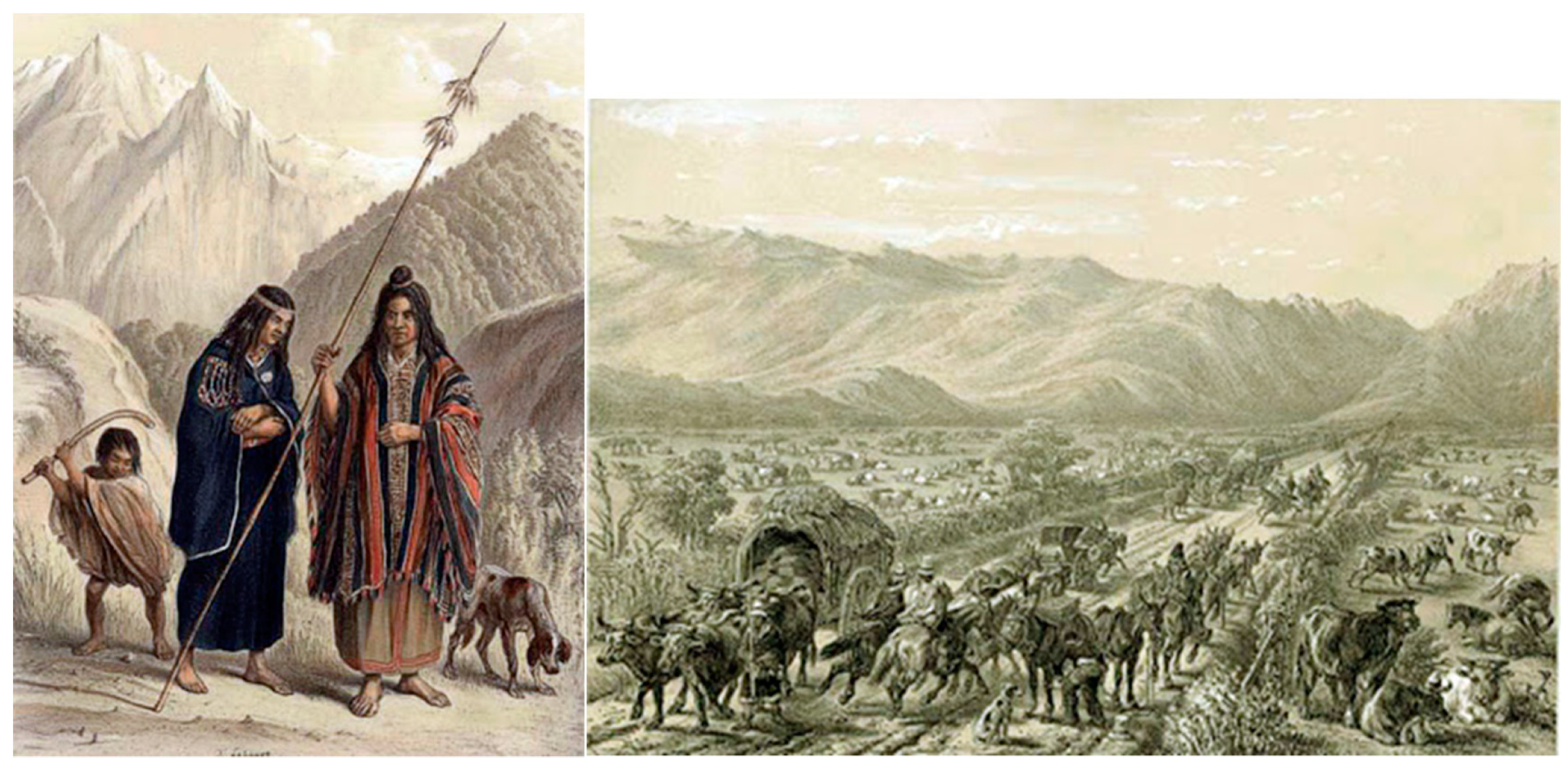
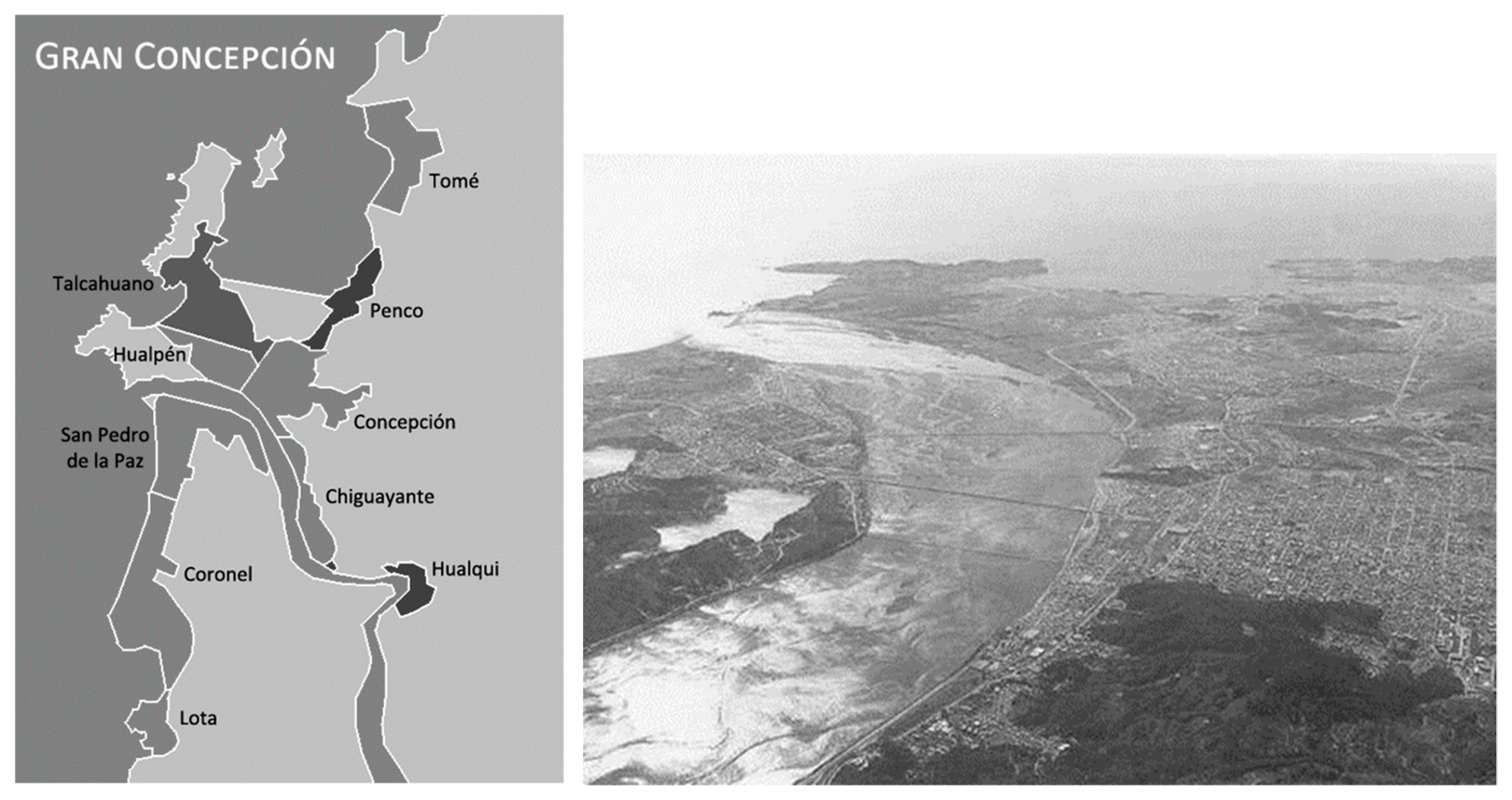
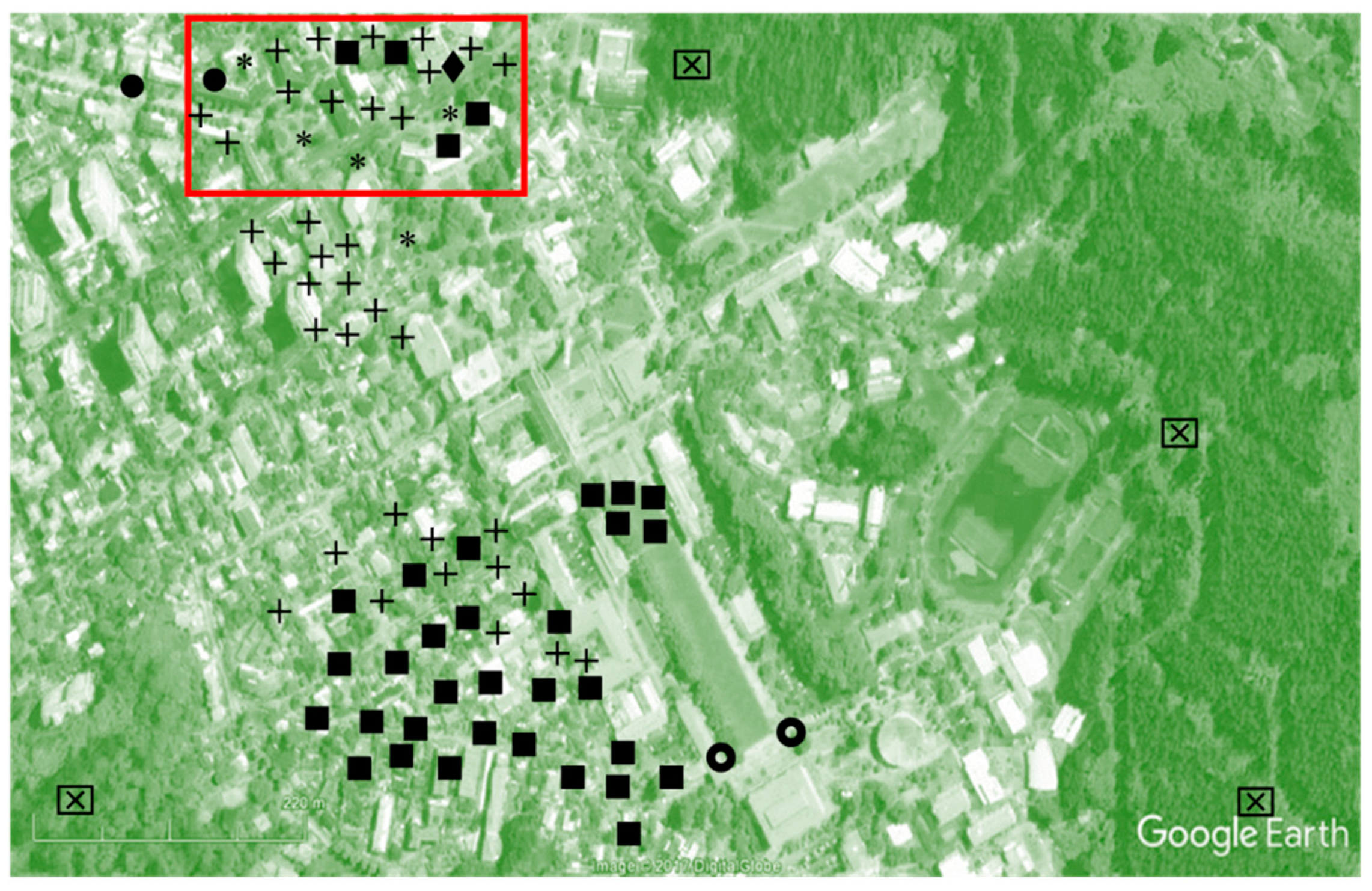
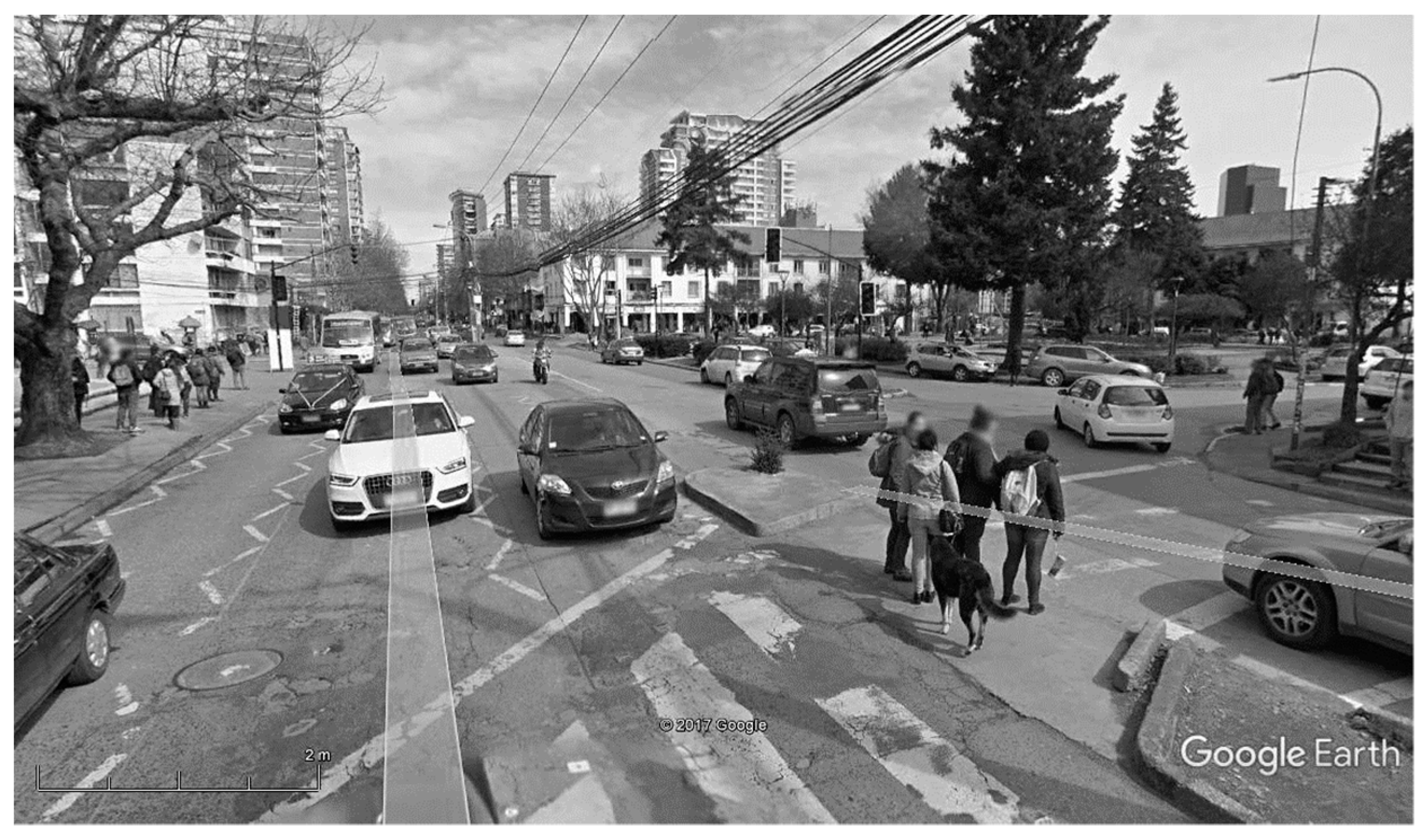
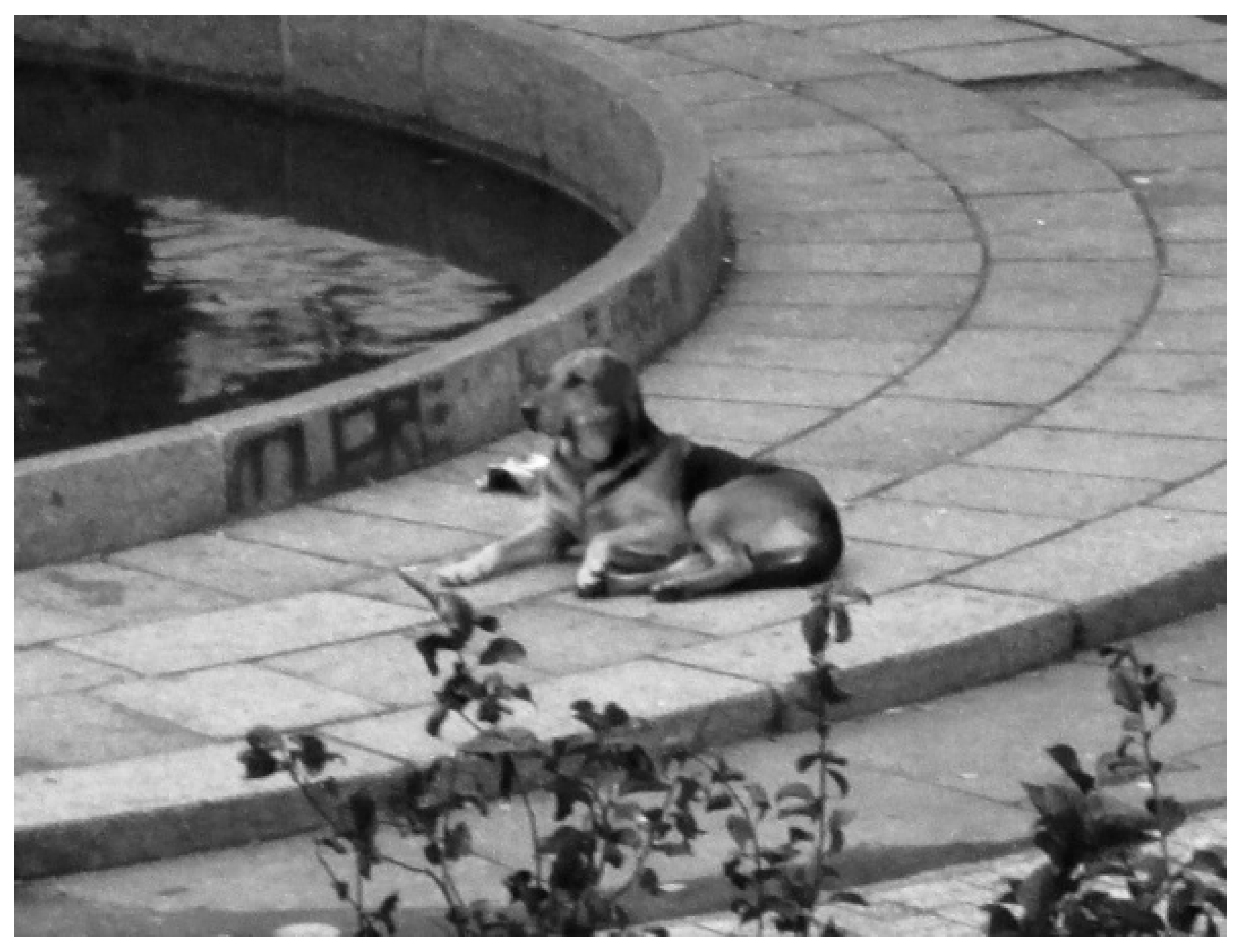
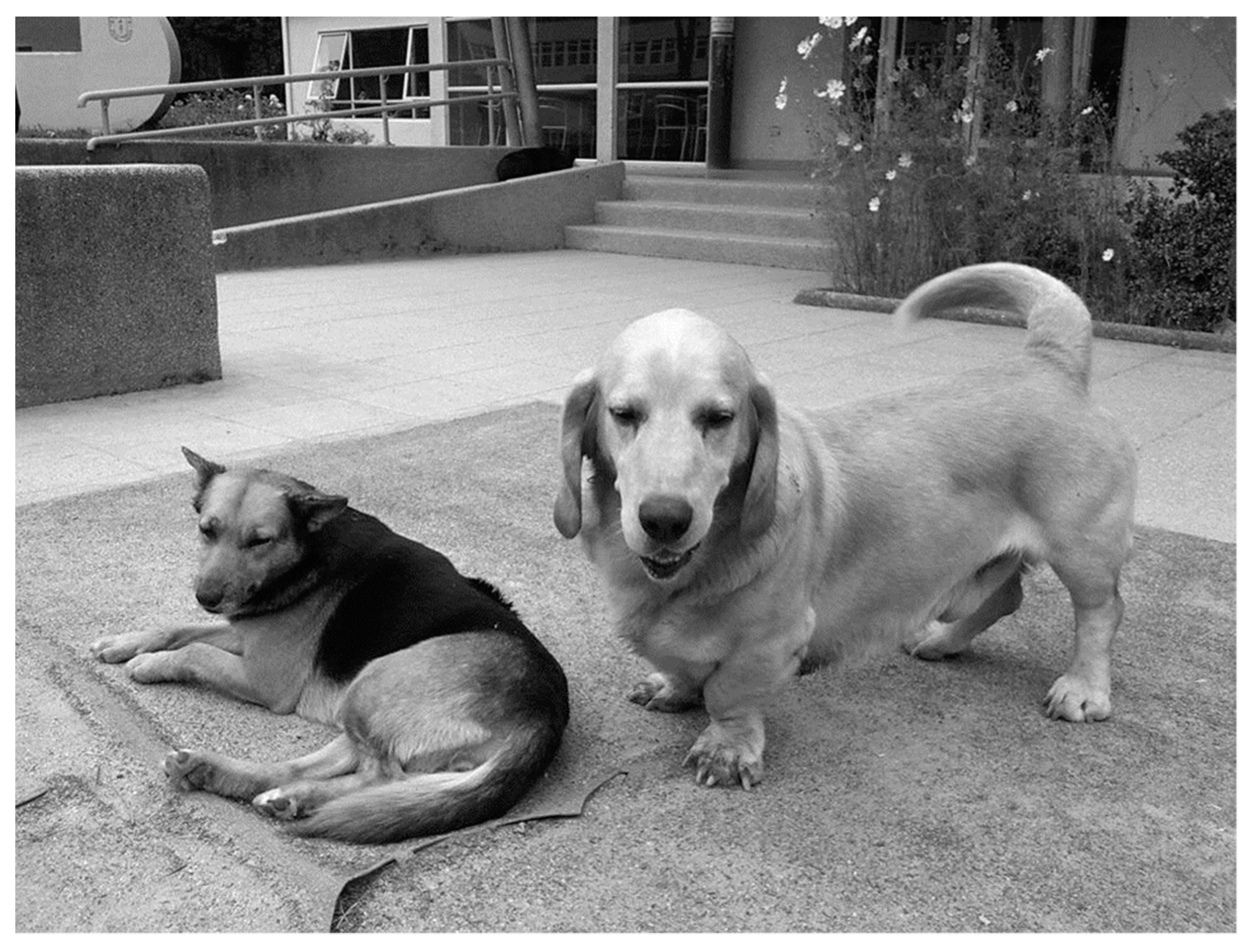
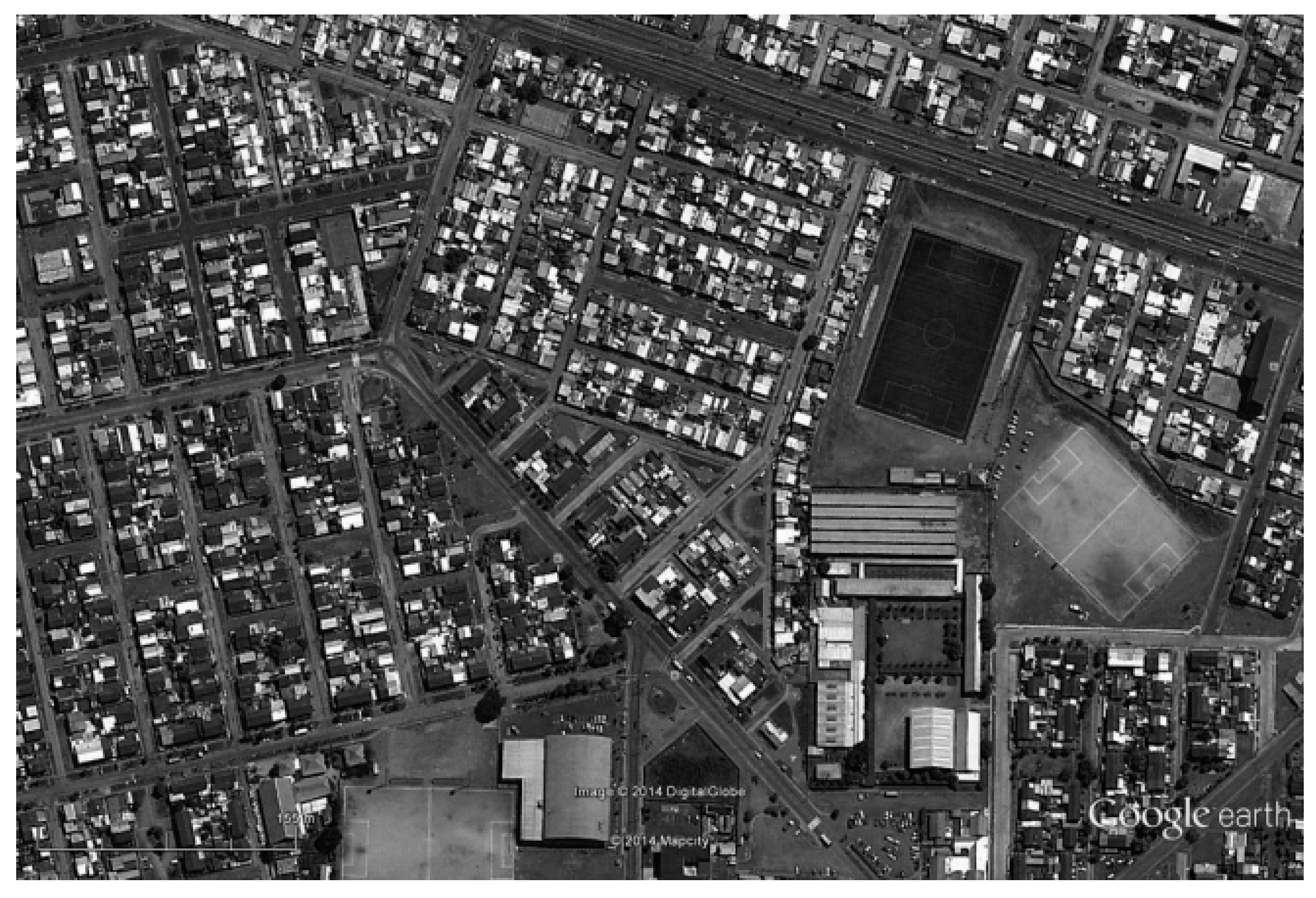
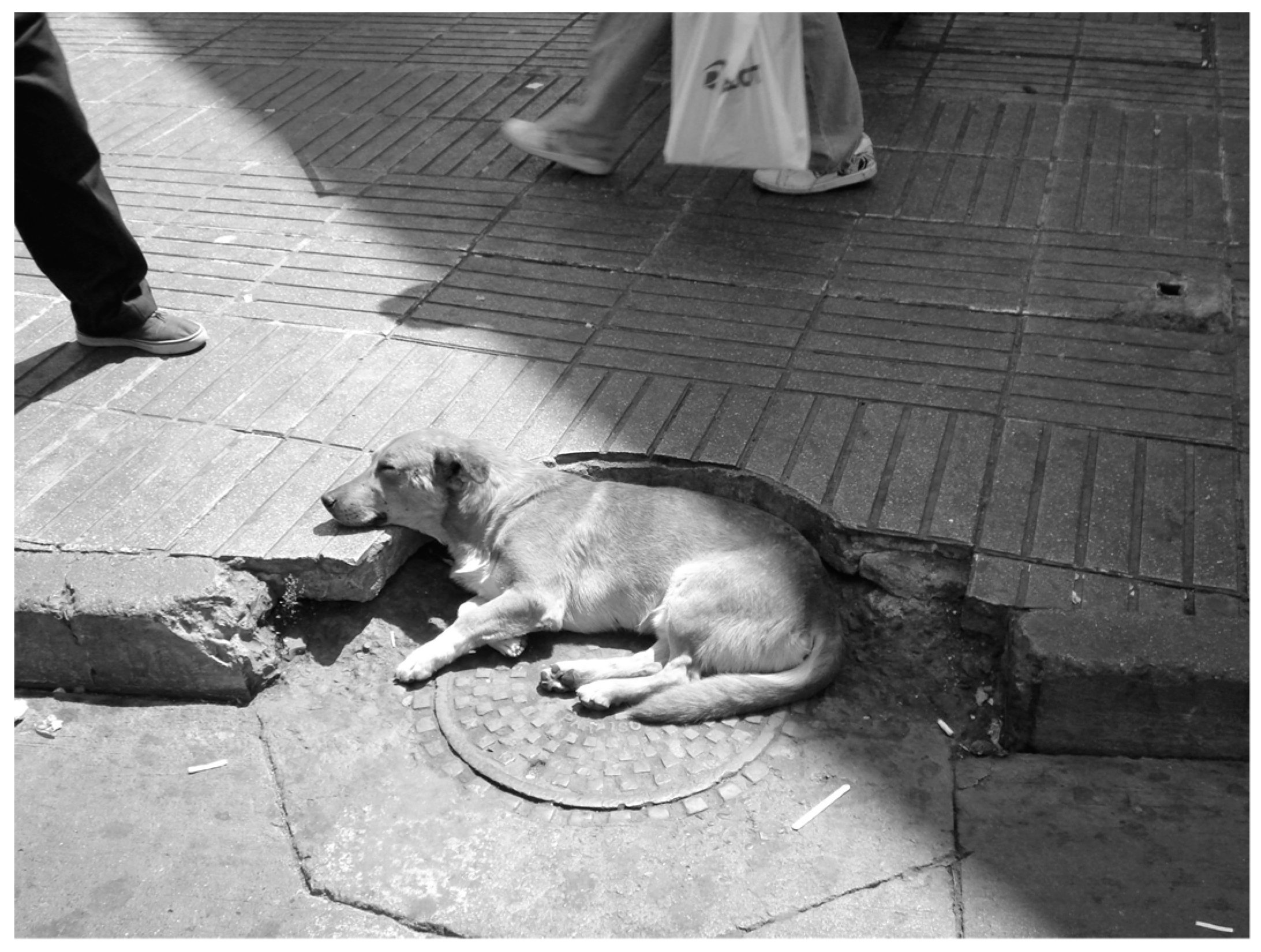
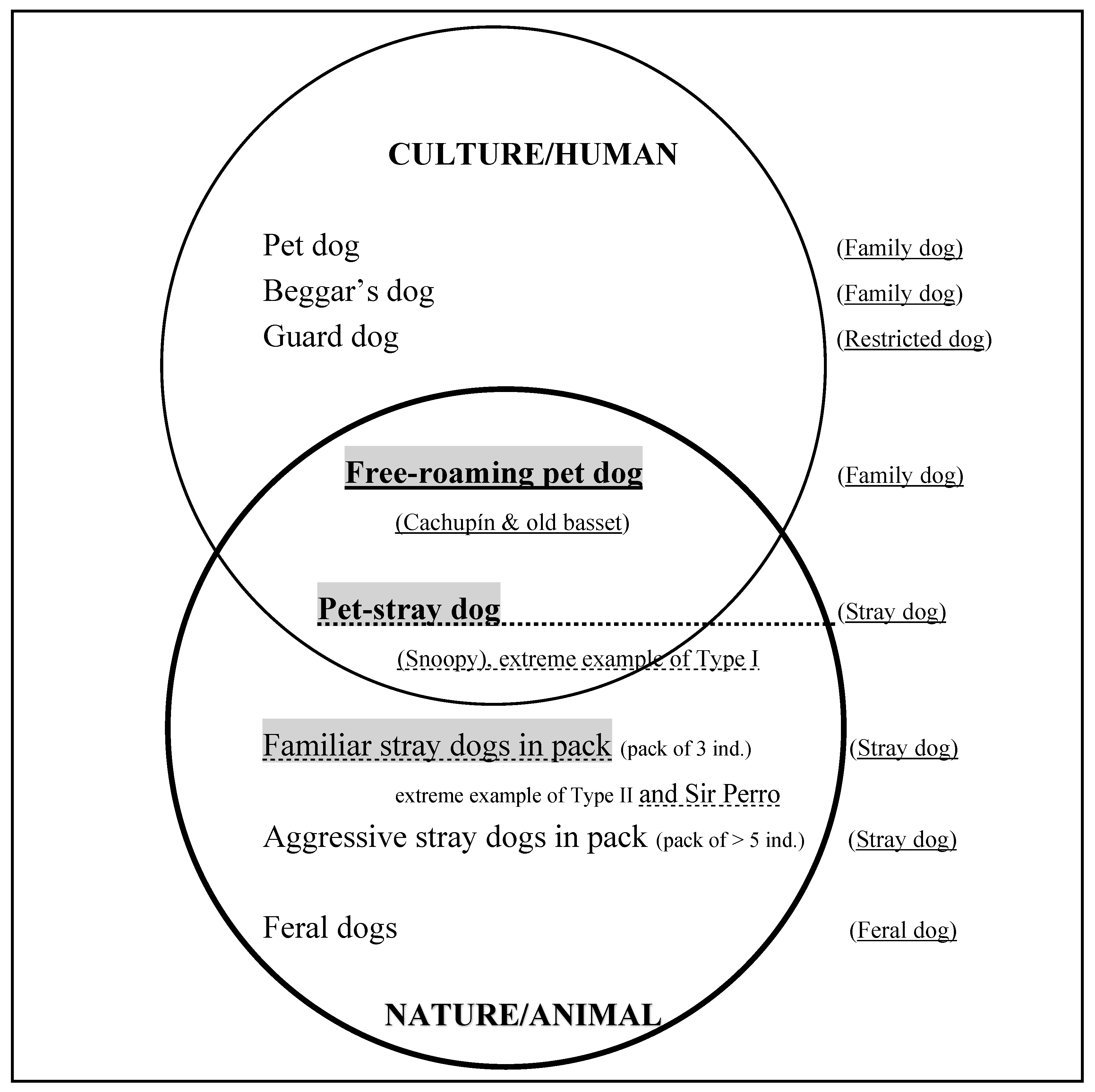
| Category of Canis Familiaris | Number of Dogs, Location(s) and Behavioral Main Characteristics | |
|---|---|---|
| ₊ | Pet dog (Family dog) | 36 dogs living at home with their owner (leashed) |
| ♦ | Beggar’s dog (Family dog) | 1 dog living unleashed with its beggar owner in the street |
| ★ | Abandoned dog (Family dog) | 1/week |
| ■ | Guard dog (Restricted dog) | 25 dogs in gardens that barked at people and other dogs 5 leashed dogs owned by security guards on the university campus 4 unleashed dogs in Plaza Perú owned by a night watchman |
| ● | Free-roaming pet dog (Family dog) | 1 pet dog that had an owner but wandered around the neighborhood all day long (Cachupín) 1 old basset pet dog that had an owner and wandered around the neighborhood all day long (Napoleon) |
| Not in Figure 4/in Hualpen | Pet-stray dog (Stray dogs) | 1 stray dog that belonged to a street and exhibited pet dog behaviors (multiple neighborhood caretakers) (Snoopy) |
| * | Familiar stray dog in a pack (Stray dogs) | 5 packs of 3 individuals, including Sir Perro |
 | Aggressive stray dog in pack (Stray dogs) | 2 packs of 5 individuals that barked at people and other dogs and bit them, as though defending the area around the library |
 | Feral dog (Feral dogs) | 4 in woods (fully solitary) |
| Total number of individuals | 103 | |
| Time of Day | Typical Daily Activities of the Familiar Stray Dogs |
|---|---|
| Morning |
|
| Midday |
|
| Afternoon |
|
| Nightfall |
|
| Listed Categories of Dogs in the Literature | New/Additional Categories of Dogs Evidenced | |
|---|---|---|
| Restricted dog | Guard dog | |
| Family dog | Pet dog | |
| Beggar’s dog | ||
| Abandoned dog | ||
| Free-roaming pet dog (Cachupín) | ||
| Stray dog | Pet-stray dog (Snoopy) | |
| Familiar stray dog in a pack (quiltros) | ||
| Aggressive stray dog | ||
| Feral dog | ||
© 2020 by the authors. Licensee MDPI, Basel, Switzerland. This article is an open access article distributed under the terms and conditions of the Creative Commons Attribution (CC BY) license (http://creativecommons.org/licenses/by/4.0/).
Share and Cite
Capellà Miternique, H.; Gaunet, F. Coexistence of Diversified Dog Socialities and Territorialities in the City of Concepción, Chile. Animals 2020, 10, 298. https://doi.org/10.3390/ani10020298
Capellà Miternique H, Gaunet F. Coexistence of Diversified Dog Socialities and Territorialities in the City of Concepción, Chile. Animals. 2020; 10(2):298. https://doi.org/10.3390/ani10020298
Chicago/Turabian StyleCapellà Miternique, Hugo, and Florence Gaunet. 2020. "Coexistence of Diversified Dog Socialities and Territorialities in the City of Concepción, Chile" Animals 10, no. 2: 298. https://doi.org/10.3390/ani10020298
APA StyleCapellà Miternique, H., & Gaunet, F. (2020). Coexistence of Diversified Dog Socialities and Territorialities in the City of Concepción, Chile. Animals, 10(2), 298. https://doi.org/10.3390/ani10020298







